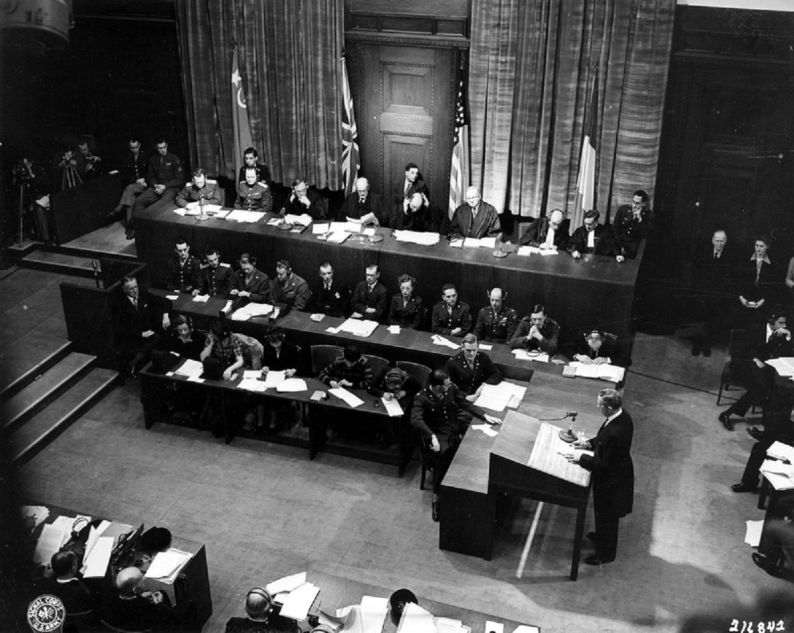“Operation Barbarossa” is the code name of the plan for the quick invasion of the USSR by Nazi Germany, that it tried to realise from June to September 1941. This document proved Germany’s pre-planned aggression against the Soviet Union. On 26 November, US prosecutor Sidney Alderman presented it to the International Military Tribunal at Nuremberg.
Alderman stated that the plan proved the “premeditation and deliberation which preceded the attack”. He presented the court with secret directive Number 21 issued by the Wehrmacht High Command of the Armed Forces (Oberkommando der Wehrmacht, OKW) from 18 December 1940 that approved the plan. The document, found in the archives of the High Command of the Land Forces (Oberkommando des Heeres, OKH) in Flensburg, was signed by Hitler and endorsed by two of the defendants – Alfred Jodl and Wilhelm Keitel.
The plan was named after medieval German Emperor Frederick I Barbarossa (lit. red beard in Italian), who became famous for his military victories. The plan provided for a sudden attack, defeat of the Red Army, and conquest of the European part of the Soviet Union in four to five months. The operation’s success was to be ensured by state-of-the-art military equipment and the effect of surprise.
In 1939, Germany and the USSR signed а non-aggression pact, in which the two countries agreed to take no military action against each other for the next 10 years. By the middle of 1940, the Third Reich and Axis powers controlled all but the neutral countries on the European mainland. However, in May-June of that year Germany failed to achieve a quick victory over Great Britain. To deny the British their last possible ally in Europe, the Fuhrer decided to defeat the USSR in one strike:
“With Russia smashed, Britain's last hope would be shattered. Germany will then be the master of Europe and the Balkans”. (Hitler at a Military Planning Conference at the Berghof, 31 July 1940)
The Wehrmacht High Command of the Land Forces (OKH) postponed the plan to seize the British Isles for the invasion of the USSR, and on 21 July began preparing for war in the east. After the defeat of the USSR and Britain’s surrender, it was assumed that the United States would not interfere in the conflict either.
On 31 January 1941, the OKW finalised its plan and issued a “Directive on the Concentration of Forces”. That document outlined Operation Barbarossa’s key strategic concept of “splitting the front of the main forces of the Russian Army concentrated in the western part of Russia by means of rapid and deep strikes by powerful mobile groups north and south of the Pripet Marshes; and, exploiting this breakthrough, to destroy the disconnected groups of hostile forces”. The operation was set to commence on 15 May, but later, following the Wehrmacht’s offensive in the Balkans, it was postponed to 22 June.
In total, the Soviet Union was to be invaded by over 150 German divisions, whose numbers amounted to four million soldiers. The plan included the participation of Germany's allies. Finnish troops were to stage an offensive on the Karelian Isthmus and, if necessary, east of Lake Ladoga, Romanian troops were to support the Army Group South's offensive and guard the rear.
Another secret document presented by Alderman was a memorandum from 2 May 1941, concerning the result of a discussion that same day with the state secretaries concerning Operation Barbarossa. The text testifies that the Nazis were fully aware of the consequences of an attack on the Soviet Union.
Alderman cited the first two paragraphs of that document:
- The War can only be continued if all Armed Forces are fed by Russia in the third year of war.
- There is no doubt that as a result many millions of people will be starved to death if we take out of the country the things necessary for us”.
“Perhaps there never was a more sinister sentence written than the sentence in this document”, the prosecutor commented.
Directives and orders supplementing the plan recognised war crimes against Soviet citizens as admissible. They ordered to kill captured commissars, communists, Jews, and partisans.
Germany failed to fully carry out its Operation Barbarossa. In May 1941, the Red Army began to deploy forces in the west – despite the peace agreement with Germany, the USSR feared that there would be war. Joseph Stalin, however, was confident that Hitler would not violate the peace agreement in the near future, and even ignored intelligence reports. As a result, the Soviet forces on the border were unprepared for either an offensive or for defence (for the most part, they were either stationed in places of permanent deployment or were on marches). So, the Wehrmacht, which greatly outnumbered the Red Army, seized the strategic initiative in the first weeks of the war.
The German forces achieved their greatest progress in the north, conquering the Baltics and reaching Leningrad. On 16 July, the enemy occupied Smolensk in the centre, but afterwards, the offensive stalled for several weeks. The hardest development was in the south.
The German attack on Moscow began on 30 September, but by that time it had become clear that the original plan for Operation Barbarossa had failed.
By Daniil Sidorov
























